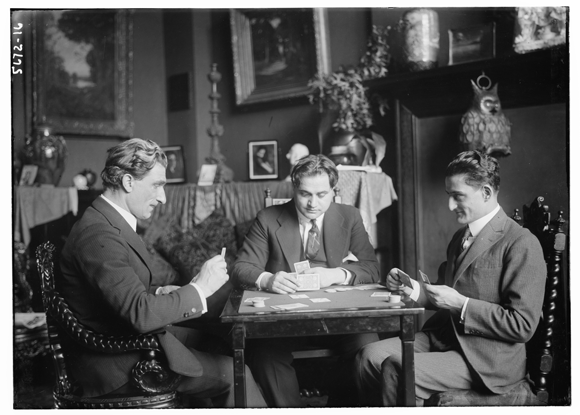A short distance from Corbett's, on 33rd Street between Fifth and Sixth Avenues, in an inconspicuous townhouse, was one of the city's most notorious gambling halls, the House with the Bronze Door. With lavish interiors designed by Stanford White of McKim, Mead and White, and an entrance fortified by a reclaimed 15th century bronze door, the House kept the wealthy in, and unsympathetic lawmakers out. (There were plenty of sympathetic lawmakers at the poker tables too.)
 |
| Men playing cards c. 1900. Image: LOC |
Players won big and lost bigger in the House's gaming rooms, which included roulette, poker, baccarat. In case of raids, guests could escape through a secret route via an adjoining building. Owner Frank Farrell used the profits from the House with the Bronze Door to fund over 200 other illegal gambling dens throughout the city. He also used the profits to bribe members of law enforcement, most of who belonged to the Tammany Society, a corrupt political machine that controlled city and state politics for decades.
 |
| Harper's Weekly cartoon by William A. Rogers showing NYC Chief of Police "Big Bill" Devery collecting "taxes". Image and further explanation: Harp Week |
Members of the Tammany Society were widely known to accept and require bribes and selectively enforce laws. Public approval of the organization fluctuated, though its powerlessness in the face of Tammany was recognized by several media outlets. With low rates of literacy, satirical cartoons reached a much wider audience than written diatribes could. It was a winning hand, and they accomplished in part, what Tammany feared the most, exposure to, and criticism from, the public. One of the most notable cartoonists was Thomas Nast of Harper's Weekly. Throughout his years at the paper, he produced a huge number of sardonic cartoons for the heavily circulated weekly, often showing Tammany as an irate tiger destroying everything in its path.
 |
| Harper's Weekly cartoon by Thomas Nast, November 11, 1897 showing Tammany tiger mauling democracy (depicted as Columbia with a crushed ballot box by her side) in a Roman Colosseum as Boss Tweed cheers from the stands. Image: OSU |
Reformists, such Reverend Charles C. Parkhurst and Jerry McAuley played huge roles in publicizing Tammany's wrongs through well-attended sermons. In 1891 Reverend Parkhurst inaugurated a campaign against Tammany Hall. He gave sermons throughout the city denouncing public officials, and made it his personal mission to shut down all gambling halls. The effort eventually succeeded with the closure of several gaming rooms throughout the city, including the House with the Bronze Door in 1908. The defeat was celebrated in person and in print, though the Tammany Society would continue to operate in some form or other for several more decades.
 |
| Reverend Charles C. Parkhurst enjoys a brief victory over Tammany in this cartoon by J.S. Pughe, printed in an 1894 edition of Puck. Image: LOC |
Further Reading:
1. Dash, Mike. Satan's Circus: Murder, Vice, Police Corruption, and New York's Trial of the Century
2. Halloran, Fiona Deans. Thomas Nast: The Father of Modern Political Cartoons
3. Gilfoyle, Timothy. A Pickpocket's Tale
4. Santé, Luc. Low Life